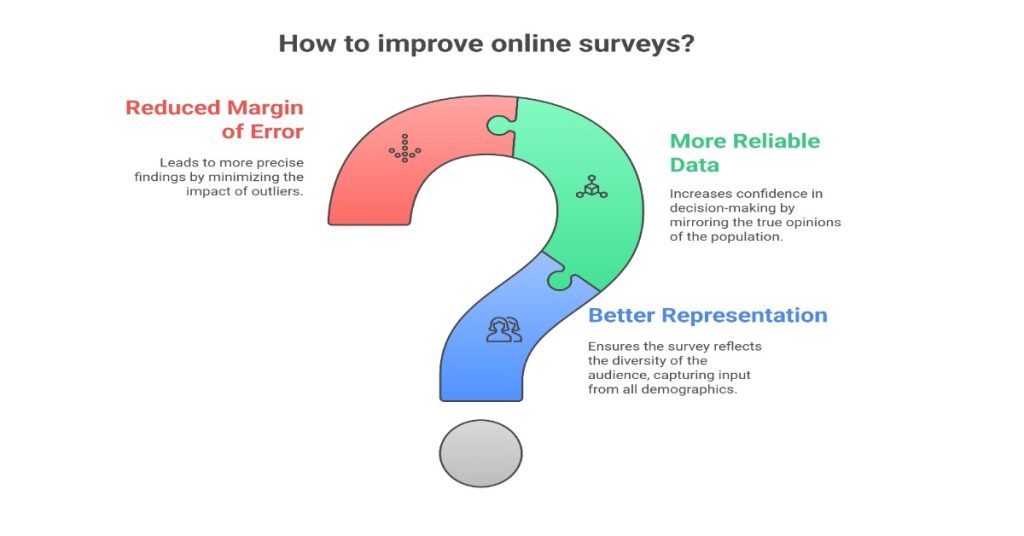Surveys are a powerful tool for gathering insights, whether you’re a marketer, researcher, or business owner. But here’s the catch: if your survey data isn’t accurate, your decisions could be based on flawed information. That’s where random sampling comes in. It’s the backbone of reliable survey results, helping you avoid biases and get a true picture of your audience.
In this blog, we’ll break down why random sampling matters, how it works, and the common mistakes people make when designing online surveys. By the end, you’ll know how to create surveys that deliver trustworthy results—without the guesswork.
Table of Contents
Why Survey Accuracy Matters?
Imagine launching a new product based on survey feedback, only to realize later that your data was skewed. Maybe your respondents were all from a specific age group or location, leaving out key perspectives. This can lead to costly missteps.
The Problem with Biased Surveys
- Self-selection bias: Only certain types of people respond (e.g., those with strong opinions).
- Convenience bias: You survey only those who are easy to reach (e.g., your email list).
- Non-response bias: People who don’t respond might have different views than those who do.
Random sampling helps you avoid these pitfalls by giving every member of your target population an equal chance to participate.

What Is Random Sampling?
Random sampling is a method where every individual in your target group has the same probability of being selected. It’s like drawing names from a hat—no favoritism, no shortcuts.
Types of Random Sampling
- Simple Random Sampling: Every member has an equal chance (e.g., using a random number generator).
- Stratified Sampling: Divide your population into groups (strata) and sample randomly within each.
- Cluster Sampling: Randomly select groups (clusters) and survey everyone within them.
- Systematic Sampling: Pick every nth person from a list (e.g., every 10th email subscriber).
Each method has its pros and cons, but the goal is the same: reduce bias.
How Random Sampling Improves Online Surveys?
Online surveys are convenient, but they’re also prone to bias. Here’s how random sampling can help:
- Better Representation
Random sampling ensures your survey reflects the diversity of your audience. For example, if you’re studying consumer preferences, you want input from all demographics—not just the most vocal ones. - More Reliable Data
When your sample is random, the results are more likely to mirror the true opinions of your entire population. This means you can make decisions with confidence. - Reduced Margin of Error
A well-chosen random sample reduces the chance of extreme outliers skewing your results. This leads to more precise findings.

Common Mistakes in Online Survey Sampling
Even with random sampling, errors can creep in. Here’s what to watch out for:
1. Ignoring the Sampling Frame
Your sampling frame is the list of people you’re drawing from. If it’s incomplete (e.g., missing certain demographics), your results will be off.
Solution: Double-check your frame. For example, if you’re surveying smartphone users, make sure your list includes all relevant age groups and regions.
2. Small Sample Sizes
A tiny sample won’t capture the full picture. For instance, surveying 50 people about a product used by millions won’t give you reliable insights.
Solution: Use a sample size calculator to determine how many responses you need for accurate results.
3. Overlooking Non-Respondents
If 70% of your invited participants don’t respond, your data might be biased toward those who did.
Solution: Follow up with reminders or offer incentives to boost participation.

Practical Tips for Implementing Random Sampling Online
Now that you know the pitfalls, here’s how to apply random sampling effectively:
- Define Your Target Population Clearly
Who exactly are you surveying? Be specific about demographics like age, location, or occupation. - Use Random Selection Tools
Platforms like SurveyMonkey or Google Forms offer random sampling features. Alternatively, use a random number generator to pick respondents from a list. - Balance Convenience with Accuracy
Online panels and social media can be quick, but they often introduce bias. Mix methods—like combining email surveys with random website pop-ups—to improve diversity. - Test Your Survey First
Run a pilot with a small random sample to catch issues before launching the full survey.

Real-World Example: How Random Sampling Saved a Marketing Campaign?
A tech company wanted to gauge interest in a new app feature. Instead of surveying only their most active users (who might love everything they release), they used stratified random sampling to include casual users, skeptics, and non-users.
The result? They discovered that while power users adored the feature, casual users found it confusing. This insight led to a redesign that made the feature more intuitive, boosting adoption rates.
Read More
Targeting the Right Audience: Strategies for Demographics in Online Surveys
Tired of Empty Surveys? Key Strategies for Getting More People to Finish Yours
Top Strategies for Boosting Survey Participation
Final Thoughts
Random sampling isn’t just a technical detail—it’s the difference between guessing and knowing. By giving everyone in your target audience a fair shot at being heard, you’ll get data you can trust.

